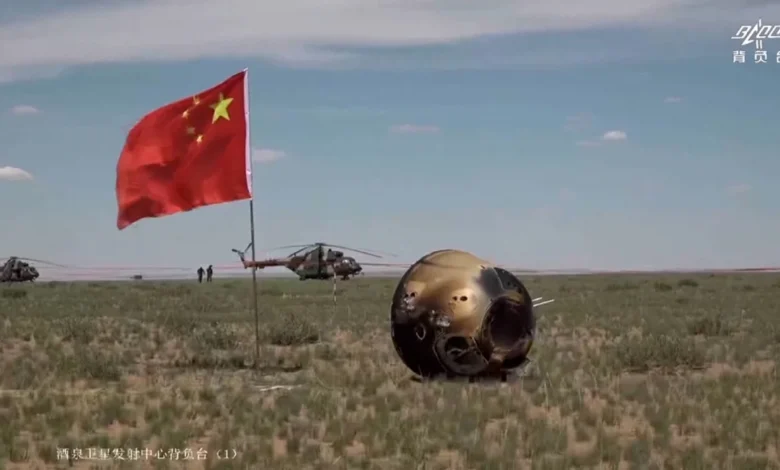China Makes Lunar History: Chang’e-6 Delivers First Far Side Soil Samples to Earth

Highlight: China has become the first country to bring soil samples from the far side of the Moon back to Earth. The Chang’e-6 lunar probe landed in China’s Inner Mongolia region on June 25, 2024, carrying approximately 2 kg of lunar soil and rock collected from the far side of the Moon.
On June 25th, 2024, China etched its name in spacefaring history. The Chang’e-6 mission successfully returned to Earth, bringing with it the first-ever lunar soil samples collected from the far side of the moon. This momentous achievement marks a significant leap in our understanding of our celestial neighbor and paves the way for further lunar exploration.
A Mission of Firsts: Unveiling the Lunar Far Side
The Chang’e-6 mission wasn’t just about collecting soil; it was a complex ballet of robotic precision. Launched on May 3rd, 2024, the mission consisted of four key components:
- Lunar Lander: This robotic spacecraft carried the drilling and collection equipment, designed to extract precious lunar soil from the South Pole-Aitken basin, one of the largest impact craters in the solar system.
- Return Capsule: This heat-resistant capsule housed the collected lunar samples and ensured their safe return through Earth’s atmosphere.
- Orbiter: This spacecraft remained in lunar orbit throughout the mission, providing vital communication and navigation support to the lander.
- Ascender: A small rocket housed within the lander, the ascender blasted the sample canister from the lunar surface, placing it on a trajectory towards Earth.
The far side of the moon, permanently hidden from Earth’s view, holds a wealth of secrets. Scientists believe the basin where Chang’e-6 landed could potentially contain material ejected from the moon’s mantle during a colossal ancient impact. Studying these samples could offer unprecedented insights into the moon’s formation and internal composition.
A 53-Day Journey: From Lunar Landing to Earthly Return
The Chang’e-6 mission unfolded over 53 thrilling days. After a successful launch from China’s Hainan Island, the spacecraft meticulously maneuvered itself into lunar orbit. On June 1st, the lander separated from the orbiter and initiated its descent towards the lunar surface. The landing itself was a marvel of automated precision, touching down flawlessly within the targeted zone of the South Pole-Aitken basin.
Once on the lunar surface, the robotic arm of the lander sprang into action, deploying the drilling equipment. The drill extracted approximately 4.4 pounds (2 kilograms) of lunar soil, carefully stored within a sealed container. On June 18th, the ascender rocket fired, propelling the sample canister on a lunar escape trajectory.
The return capsule, meanwhile, separated from the orbiter and began its journey back to Earth. After re-entering our atmosphere, the capsule’s heat shield protected its precious cargo as it blazed through the atmosphere. Finally, on June 25th, the capsule touched down safely in China’s Inner Mongolia Autonomous Region, marking the culmination of this historic mission.
A New Dawn for Lunar Science: Unveiling the Secrets of the Far Side
The Chang’e-6 mission’s success is a boon for the scientific community. The collected lunar soil will undergo rigorous analysis in specially designed laboratories. Here are some of the exciting scientific possibilities this mission unlocks:
- Understanding the Moon’s Formation: Studying the composition of the far side soil might reveal clues about the moon’s formation and early history.
- Mapping the Lunar Mantle: Scientists believe the South Pole-Aitken basin could hold remnants of material from the moon’s mantle. Analyzing the samples could provide insights into the moon’s internal structure.
- Comparison with Near Side Samples: Comparing the far side soil with samples collected from the moon’s near side could reveal valuable information about the moon’s geological asymmetry.
The Future of Lunar Exploration: Building on Chang’e-6’s Legacy
The Chang’e-6 mission is not an isolated achievement. It’s a vital step in China’s ambitious lunar exploration program, paving the way for future missions. Here’s a glimpse into what lies ahead:
- Chang’e-7 and Chang’e-8: Scheduled for launch in 2026 and 2028 respectively, these missions aim to further explore the lunar south pole and test technologies crucial for establishing a permanent lunar research station.
- International Collaboration: The success of Chang’e-6 highlights the potential for international collaboration in lunar exploration. Sharing scientific data and expertise will accelerate our understanding of our celestial neighbor.
Key Detail Highlights:
The far side of the Moon, which always faces away from Earth, poses unique challenges due to its remote location and rugged terrain. China is the only country to have achieved a soft landing on the far side, first accomplished in 2019. The Chang’e-6 mission built on this success, using a robotic arm and drill to collect samples from the South Pole-Aitken basin, a giant crater on the far side.
The returned samples are expected to provide scientists from China and around the world with new insights into the formation of the solar system and differences between the far side and near side of the Moon. This achievement is a significant boost for China’s ambitious space exploration program, as it seeks to catch up with the United States and Russia in lunar exploration.
A Giant Leap for Mankind: Chang’e-6 and the Future of Space Exploration
China’s Chang’e-6 mission is a landmark achievement, not just for the nation’s space program but for humanity as a whole. It signifies our growing capability to explore our solar system and unlock the mysteries of celestial bodies. The lunar soil samples hold the potential to rewrite our understanding of the moon’



